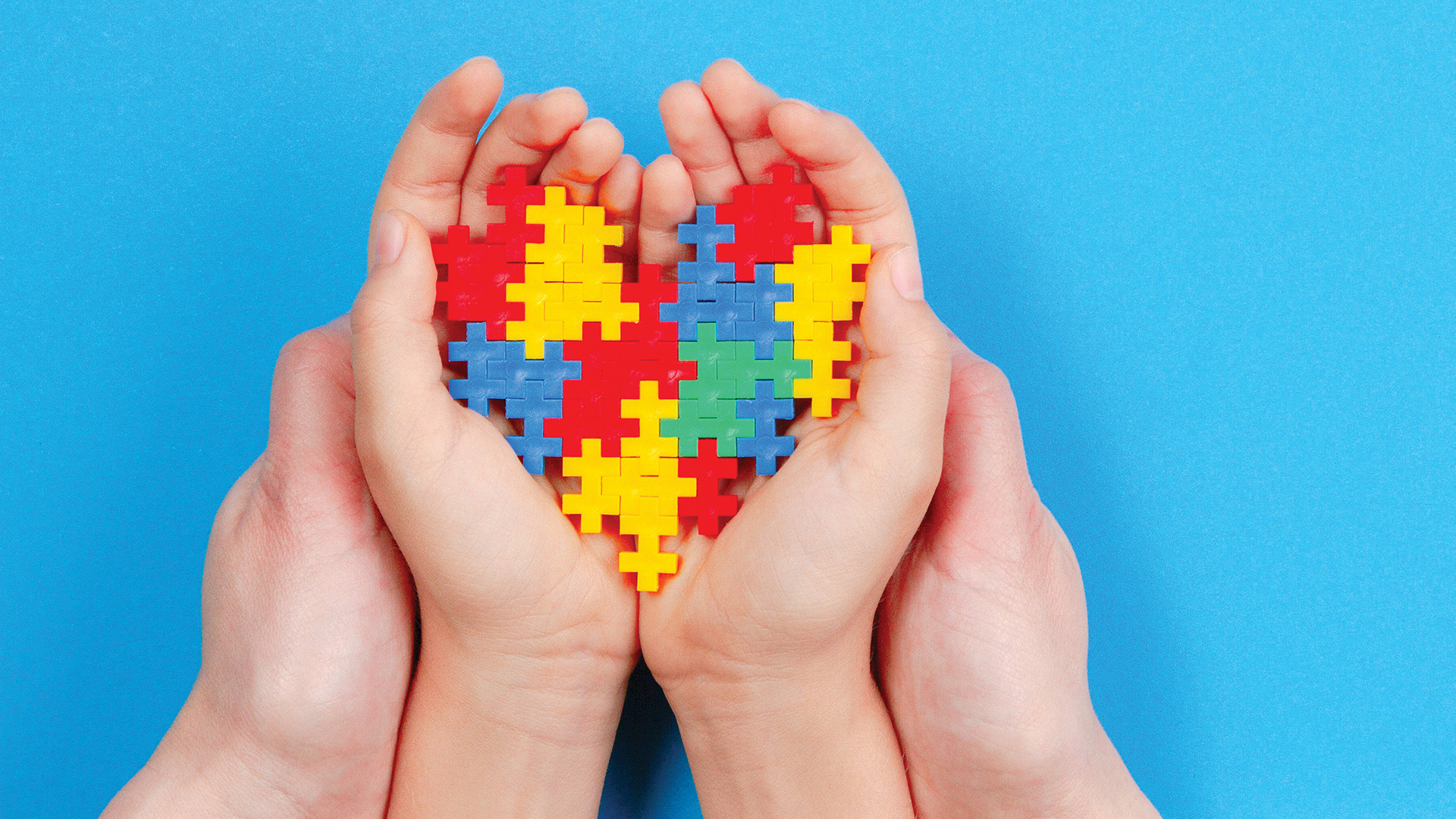‘Our brains just think a little differently’
July 1, 2020

When Jack Rogerson turned two, his parents threw him a big birthday party. They invited their family and friends around and transformed their courtyard into a playhouse with toys, a plastic slide and a Thomas the Tank Engine large enough to ride.
Only little Jack wasn’t interested. No matter how much his parents tried to cajole him, he retreated to the sidelines, preferring repetitive, solitary activities such as pulling leaves off a hedge or lining his toy cars up in a row.
“Lots of our friends and family were concerned about him around his second birthday, but we were in complete denial,” says Jack’s mother, Nicole Rogerson.
By the time Jack turned three, however, his parents had accepted that there was a problem.
“We had difficulty getting his attention, and he would throw incredible tantrums if something unexpected occurred,” says Nicole. “For example, if we said, ‘We’re going to visit Nanna today,’ but if we stopped off at the cake shop on the way, that would result in a massive tantrum because he would see we’d gone a different way.”
Nicole and her acclaimed broadcaster husband Ian Rogerson took Jack to a series of paediatricians who diagnosed him: autism.
“It was one of those things that really hit,” says Ian on an Australian Story episode, “I am Jack”. “Nic and I went off, and I still remember this, we were parked in the carpark and it was raining that day. And we both burst into tears.”
What is autism?
Autism spectrum disorder (ASD) is a neurodevelopmental disorder characterised by deficits of social interaction and restricted, repetitive behaviour. According to autism services provider, Aspect, it affects about one in 70 people in Australia.
The cause of autism is unknown, but it’s likely that genetics, environment and epigenetics (where an abnormal gene is “turned on” early in development) may all play a role. Boys are four times as likely to be diagnosed as girls, and children are more likely to be affected if they have a sibling with ASD.
There’s a huge degree of variation in how much ASD impacts an individual. Those on the mild end of the spectrum are able to live independently and maintain regular employment as adults. However, up to 70 per cent will have some degree of intellectual deficit, often being overly sensitive to certain audible and visual stimuli. Difficulties in physical motion will be present in up to 60 per cent; those more significantly affected may require specialised care. Other common coexisting conditions include epilepsy (30 per cent), attention deficit disorder (up to 50 per cent) and sleep disorders (80 per cent).

Vejaa—Getty Images
Getting a diagnosis
There is no blood test or brain scan that can diagnose ASD; rather, it is done by studying an individual’s developmental history, observing their social interactions and examining for neurological deficits.
Adelaide-based psychiatrist Harry Hustig has a number of patients with ASD and says a diagnosis of ASD is a mixed blessing. “To some extent it explains why the child is different to most other children, and certainly it reduces the guilt that parents have over not being able to emotionally connect to this child.”
Hustig advises parents to make contact with the autism body in their region once diagnosis is made. “They usually have a lot of resources and connections, and tend to de-medicalise the diagnosis,” he says.
Sydney psychologist Adam Guastella says that obtaining a diagnosis can be a costly and lengthy process. “If people don’t have the ability to pay for private specialists, it’s not uncommon for them to wait for up to a year, or even two years, for a public service assessment of their child,” he says. “But whether a child easily meets the criteria, or just meets the criteria, or just misses out on the criteria, that doesn’t answer the question of what the child actually needs.”
Focus on the positive
Brisbane psychiatrist John Down says improving the child’s function in those areas where they’re having difficulties is a team effort involving psychologists, speech pathologists, occupational therapists, physiotherapists and social workers.
“There’s been a positive move in recent years to focus less on diagnosis and more on the level of functional impairment,” Down says. “We realise now that people learn much better when you try to focus on their strengths and use their areas of strength to help them in the areas they find more difficult.”
Down, in collaboration with others, is about to begin trialling a novel augmented reality device that he hopes will help.
“Children with autism are often very sensory and there are certain things that can be very uncomfortable for them, such as loud noises and the touch of things like clothing, grass or sand,” said Down. “But often the bright lights and digital busyness of technology are both stimulating and relaxing for them.”
Early intervention key
A number of studies have shown that early intervention in a child showing signs of ASD can have significant benefits. For example, in a 2019 studyE, researchers found that the language development of babies with early signs of autism improved significantly when parents were coached to better identify and respond to their baby’s communication cues. And a 2018 study showed that shared book reading improved language skills in preschoolers with ASD.
In the early years of primary school, children with ASD don’t necessarily realise that they’re different to other children, and this can be a protective factor, says Down. “It’s often towards the latter half of primary school, as kids start becoming aware of the fact that there are differences between them and their classmates, that they can actually really struggle.”
However, the right interventions can minimise these differences, making it easier for the child to assimilate. “Support in those early years is really important,” says Down.
Nicole Rogerson, now CEO of Autism Awareness Australia, is a passionate advocate for early intervention and believes it can drastically change the outcome for a child with ASD.
“Many of them will have deficits in communication and social skills, but we know that those kinds of things can be taught,” she says. “By getting early intervention, and getting that support through school, you’re giving your child their best chance.”
As soon as Jack was diagnosed with ASD, Nicole and Ian found a speech pathologist who specialised in interventions for children with ASD. It proved to be a turning point for their son.
“When we started therapy, Jack couldn’t even imitate an action. He had a handful of simple words and very few skills,” says Nicole. “Now he works fulltime, catches public transport and goes out with friends.”
Signs to watch for
Guastella says parents should be on the lookout to see if their child is responding to others. “It’s about developmental milestones,” he says. “So, if a child at 18 months of age is not responding to their name, is isolating themselves and not engaging in play-based behaviour, then alarm bells should be going off.”
Other signs to look out for include delayed verbal communication, limited use of gestures such as pointing or waving, obsessive tendencies, being overly sensitive to certain auditory and visual stimuli, and repetitive behaviours like spinning, rocking or sucking on objects.
Diagnosis can be made from 18 months onwards, but no matter the age of the child—or even for adults, Guastella says—it’s never too late to get a diagnosis and start interventions.
As the child gets older there is occasionally a role for medication, particularly if there is self-harming or aggression as part of the ASD. “Some of the antidepressants have been shown to be useful in reducing the rage behaviour and, similarly, there are a couple of PBS-listed antipsychotics which, at a low dose, can bring about some marked changes in the individual’s behaviour,” says Hustig.

KatarzynaBialasiewicz—Getty Images
A better future
“The field is changing to better respond to the family’s needs,” Guastella says. “There’s a massive shift away from just labelling someone with autism and saying they’ve got problems, to now saying, ‘Actually, this person has a whole range of skills and strengths.’”
State education departments now offer a range of resources to help support children with ASD, ranging from allocating a “calm zone” in the classroom to implementing a structured teaching plan and providing a quiet room where the child can complete their tests.
The workforce has also been evolving, with employees becoming more aware of workers with ASD and providing employment opportunities that take advantage of their strengths. Those on the spectrum will often excel in jobs that require repetitive tasks in relative isolation, such as information technology, photography, mechanics, cleaning and accounting.
“They have less days off than the general population,” says Hustig. “They actually like the routine. It’s a case of finding them the right job that suits their talents.”
One of the biggest changes, however, has been trying to give people with ASD a voice in the community. “There have been lots of surveys and co-designed research studies. They want relationships. They want employment. They pretty much want what everyone wants,” says Guastella.
This is certainly true for Jack, now 24. In 2014, he graduated from high school and went on to complete his chef apprenticeship. Currently he is working fulltime at the Harris Farm Markets in Bondi Beach, Sydney.
When asked what he wants for his future, Jack says, “To be happy, with good friends and a good job, and to go to lots of concerts.”
He wishes other people would understand that people with ASD are just like everyone else. “Our brains just think a little differently,” he said.
“Don’t be so scared of autism,” says Nicole. “It’s not the end of the earth. It’s going to be a different life to the one you were expecting, but there’s going to be an enormous amount of benefits that come with it as well.”
As for Jack, he has pertinent advice for others with ASD. “Just be yourself, make your own choices and do what you want to do,” he said. “No-one can judge your life.”
Suvi Mahonen is a freelance journalist based on Queensland’s Gold Coast, where she lives with her family. She has a passion for healthcare and the emergence of innovative and effective treatments.
1. Srivastav AK & Schwartz CE (2014). “Intellectual Disability and Autism Spectrum Disorders: Causal Genes and Molecular Mechanisms”, Neuroscience Biobehaviour Review, Oct; 46 Pt 2: 161–174.
2. Lai MC, Lombardo MV & Baron-Cohen S (2014). “Autism”, The Lancet, Vol 383, Issue 9920, 896–910.
3. Whitehouse AJO, Varcin KJ et al (2019). “Pre-emptive intervention versus treatment as usual for infants showing early behavioural risk signs of autism spectrum disorder: a single-blind, randomised controlled trial”, The Lancet, Child & Adolescent Health, Vol 3, Issue 9, 605–615.
4. Griffith University (2018). “Helping families improve early literacy skills for children on the autism spectrum”, Griffith News, June 14.







